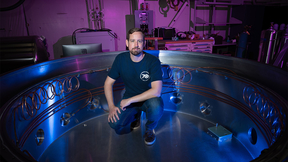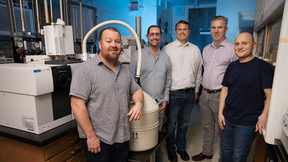Back
Nuclear, Chem, and Isotopic S&T
Inside the Lab: Meet the team protecting America from nuclear threats
In the latest episode of its “Inside the Lab” YouTube series, Lawrence Livermore National Laboratory (LLNL) is featuring the Radiological Assistance Program (RAP), offering a rare look at how national laboratory scientists support high-stakes nuclear and radiological emergency response operations. Watch the episode here. RAP is part of the U.S. Department of Energy’s…
LLNL physicist Cole Pruitt honored with early-career achievement award
Lawrence Livermore National Laboratory (LLNL) physicist Cole Pruitt has been awarded the 2025 Facility for Rare Isotope Beams (FRIB) Achievement Award for Early Career Researchers in theoretical nuclear physics. The national honor recognizes early-career scientists who have made significant contributions to nuclear physics research at or in connection with FRIB. Pruitt, a…
LLNL demonstrates new model that explains plutonium’s peculiar behavior
Normally, materials expand when heated. Higher temperatures cause atoms to vibrate, bounce around and take up a larger volume. However, for one specific phase of plutonium — called delta-plutonium — the opposite inexplicably occurs: it shrinks above room temperature. As part of its national security mission, Lawrence Livermore National Laboratory (LLNL) aims to predict the…
LLNL’s Sichi Li appointed to JACS Au Early Career Advisory Board
JACS Au, an open-access journal from the American Chemical Society, has selected Lawrence Livermore National Laboratory (LLNL) staff scientist Sichi Li to serve on its 2025–2026 Early Career Advisory Board. JACS Au publishes high-impact, cutting-edge research across the full spectrum of chemistry and related disciplines. The Early Career Advisory Board is composed of…
Nuclear chemistry research gets an efficiency boost
Heavy actinides — elements at the bottom of the periodic table, after plutonium — are radioactive, rare and chemically complex, making them notoriously difficult to study. Most studies conducted on these elements have traditionally been done one-compound-at-a-time or extrapolated from less toxic and non-radioactive surrogates, like lanthanides, that are safer to work with…
Search for sterile neutrinos continues at nuclear reactors
Neutrinos, elusive fundamental particles, can act as a window into the center of a nuclear reactor, the interior of the earth, or some of the most dynamic objects in the universe. Their tendency to change "flavors" may provide clues into the prominence of matter over antimatter in the universe or explain the existence of dark matter. Physicists are particularly interested…
LLNL hosts Nuclear Science and Security Consortium workshop
Once a year, a community of university professors, students and national lab researchers who focus on nuclear science and security gather to share research updates and develop collaborations, among other tasks. The group — known as the Nuclear Science and Security Consortium (NSSC) — recently held its workshop at the Lawrence Livermore National Laboratory (LLNL). The NSSC…
Three LLNL scientists honored with presidential early-career award
In an announcement this week, President Biden awarded the Presidential Early Career Award for Scientists and Engineers (PECASE) to nearly 400 distinguished scientists and engineers, recognizing their exceptional contributions and potential for leadership in their research fields. Among the honorees are three distinguished researchers from Lawrence Livermore National…
'Lighting' up antineutrino detection
How do you find and measure nuclear particles, like antineutrinos, that travel near the speed of light? Antineutrinos are the antimatter partner of a neutrino, one of nature’s most elusive and least understood subatomic particles. They are commonly observed near nuclear reactors, which emit copious amounts of antineutrinos, but they also are found abundantly throughout the…
LLNL’s Gauthier Deblonde selected as ‘Rising Star’
Lawrence Livermore National Laboratory (LLNL) staff scientist Gauthier Deblonde has been named a 2024 “Rising Star“ by the American Chemical Society for his work in environmental science. Deblonde’s research as well as this year’s cohort of winners will be featured in a special issue of the American Chemical Society journal ACS Environmental Au. Deblonde’s research also…
LLNL's Buddemeier named to National Academies board
Lawrence Livermore National Laboratory (LLNL) certified health physicist Brooke Buddemeier has been appointed to a panel of the National Academies of Sciences, Engineering and Medicine. A 35-year Lab employee, Buddemeier has been named to the Nuclear and Radiation Studies Board (NRSB), which provides advice about safety, security, technical efficacy and other issues…
LLNL marks milestone with NNSA acceptance of first digital product, Nightwatch
The National Nuclear Security Administration (NNSA) has accepted Nightwatch, the first digital product developed and produced by Lawrence Livermore National Laboratory (LLNL). The acceptance of the digital product — or software or firmware set to be integrated into the nuclear stockpile — was celebrated with a recent ceremonial “stamping” event, marking its compliance with…
All ears on the Big Ideas Lab podcast
Lawrence Livermore National Laboratory (LLNL) has big ideas and is showing the world in the Big Ideas Lab weekly podcast that takes listeners behind the fences and into its heart. “This is where big ideas come to life,” said Lab Director Kim Budil. “To do this, we bring together dynamic teams of many different disciplines — laser physicists and materials scientists and…
Experiment sets new record in search for dark matter
Figuring out the nature of dark matter, the invisible substance that makes up most of the mass in our universe, is one of the greatest puzzles in physics. New results from the world’s most sensitive dark matter detector, LUX-ZEPLIN (LZ), have narrowed down possibilities for one of the leading dark matter candidates: weakly interacting massive particles, or WIMPs. LZ, led…
Unveiling Bennu asteroid samples
Now at Lawrence Livermore National Laboratory (LLNL) lies a piece of ancient history. Very ancient history. The material, at just 120 milligrams, will provide information about the early solar system, planetary formation, and potentially, even ingredients for life on ancient Earth. LLNL scientists recently received and will analyze samples from the asteroid Bennu that will…
Unravelling the chemistry of heavy elements
Molecular compounds with heavy elements, like americium, curium and others can now be synthesized in a streamlined and efficient way thanks to a new technique developed by Lawrence Livermore National Laboratory (LLNL) researchers. The new pathway can help scientists perform serial chemistry with radioactive elements and could be used to speed up R&D for nuclear waste…
Nano-confinement may be key to improving hydrogen production
Researchers at Lawrence Livermore National Laboratory (LLNL) have discovered a new mechanism that can boost the efficiency of hydrogen production through water splitting. This research, published in ACS Applied Materials & Interfaces, was featured on the journal cover and provides new insights into the behavior of water reactivity and proton transfer under extreme…
LLNL gamma-ray sensor has the best resolution
It’s official. An instrument designed and built by Lawrence Livermore National Laboratory (LLNL) researchers is the highest-resolution gamma ray sensor that has ever flown in space. The Livermore high-purity germanium (HPGe) gamma ray sensor is an essential part of a larger gamma-ray spectrometer (GRS) built in collaboration with researchers from Johns Hopkins Applied…
Lab scientist wins Springer Thesis Award for work in neutrino research
Lawrence Livermore National Laboratory (LLNL) postdoc Sam Hedges has won a 2024 Springer Thesis Award for his work in searching for the elusive neutrino. “I’m honored that my thesis was nominated for this award, and was excited when I found out it had won,” Hedges said. His thesis, “Low Energy Neutrino-Nucleus Interactions at the Spallation Neutron Source," highlights the…
Hot stuff: A new thermal pathway for a high explosive
TATB (1,3,5-triamino-2,4,6-trinitrobenzene) is an important explosive compound because of its extensive use in munitions and world-wide weapons systems. Despite its importance, researchers have been trying to understand its response to temperature extremes for the past 50 years. A Lawrence Livermore National Laboratory (LLNL) team has uncovered a new thermal decomposition…

























